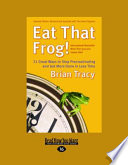

Setting clear and specific goals is the cornerstone of effective time management and productivity. In 'Eat That Frog!', Brian Tracy emphasizes the importance of defining your objectives in a way that is measurable and time-bound. This clarity not only gives you direction but also helps you prioritize tasks effectively. When you know what you want to achieve, you can focus your energy on activities that align with your goals rather than getting sidetracked by less important tasks. This idea reinforces the concept of working smarter, not harder, and encourages readers to visualize their success and map out actionable steps to reach their desired outcomes.
Continue readingTracy introduces the 'ABCDE' method of prioritization, which categorizes tasks based on their importance and urgency. The 'A' tasks are the most important, while 'E' tasks can be eliminated. This systematic approach allows individuals to focus on high-impact activities that contribute significantly to their goals. By understanding the difference between urgent and important tasks, readers can avoid the trap of spending time on activities that yield little value. This idea promotes the practice of tackling the most challenging tasks first, hence the title 'Eat That Frog!', which symbolizes confronting your biggest challenges head-on.
Continue readingEstablishing a consistent daily routine is crucial for maximizing productivity. Tracy suggests that routines create a sense of order and help individuals manage their time more effectively. By setting aside specific times for various activities, you can ensure that you allocate time for your most important tasks. Routines also reduce decision fatigue, as you don’t have to waste mental energy deciding what to do next. This idea encourages readers to create habits that align with their goals, leading to improved efficiency and a greater sense of accomplishment.
Continue readingThe Pareto Principle, or the 80/20 rule, is a vital concept in 'Eat That Frog!'. Tracy explains that 80% of your results come from 20% of your efforts. Recognizing this principle allows individuals to identify the few tasks that will yield the most significant results and prioritize them. By focusing on these high-value activities, you can maximize your productivity and minimize wasted effort. This idea serves as a reminder to work smarter by concentrating on what truly matters and delegating or eliminating tasks that do not contribute significantly to your goals.
Continue readingProcrastination is a common barrier to productivity, and Tracy provides strategies to overcome it. He emphasizes the importance of taking immediate action on tasks, no matter how small the step may be. By breaking larger tasks into manageable chunks, individuals can reduce the feeling of overwhelm and make progress. This idea encourages readers to adopt a proactive mindset, where taking action becomes a habit, thus combating the tendency to delay important tasks. Tracy also discusses the psychological aspect of procrastination, suggesting that a shift in mindset can lead to greater motivation and efficiency.
Continue readingVisualization is a powerful tool that Tracy advocates for enhancing motivation and focus. By visualizing the successful completion of tasks and the achievement of goals, individuals can create a mental picture that inspires them to take action. This idea is rooted in the belief that seeing oneself succeed can translate into real-world motivation. Tracy encourages readers to engage in positive visualization exercises regularly, reinforcing their commitment to their goals and fostering a mindset geared toward success.
Continue readingTracy stresses the importance of lifelong learning and self-improvement as essential components of personal and professional growth. He encourages readers to invest in their skills and knowledge through reading, attending seminars, and seeking mentorship. This idea promotes a growth mindset, where individuals view challenges as opportunities to learn rather than obstacles. By committing to continuous improvement, readers can enhance their productivity and effectiveness, ensuring they remain competitive and capable in an ever-changing environment.
Continue reading